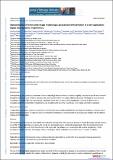Standardization of Whole Slide Image Morphologic Assessment With Definition of a New Application: Digital Slide Dynamic Morphometry

View/
Author
Puppa, Giacomo
Sheahan, Kieran
Zlobec, Inti
Pecori, Sara
Langner, Cord
Nakamura, Takatoshi
Ueno, Hideki
Senore, Carlo
Herlin, Paulette
Risio, Mauro
Vieth, Michael
Lugli, Alessandro
Wang, LaiMun
Mitomi, Hiroyuki
Watanabe, Masahiko
Chasle, Jacques
Conley, Stephen A.
Note: Order does not necessarily reflect citation order of authors.
Published Version
https://doi.org/10.4103/2153-3539.86830Metadata
Show full item recordCitation
Puppa, Giacomo, Kieran Sheahan, Inti Zlobec, Sara Pecori, Cord Langner, Takatoshi Nakamura, Hideki Ueno, et al. 2011. Standardization of whole slide image morphologic assessment with definition of a new application: Digital slide dynamic morphometry. Journal of Pathology Informatics 2(1): 48.Abstract
Background: In histopathology, the quantitative assessment of various morphologic features is based on methods originally conceived on specific areas observed through the microscope used. Failure to reproduce the same reference field of view using a different microscope will change the score assessed. Visualization of a digital slide on a screen through a dedicated viewer allows selection of the magnification. However, the field of view is rectangular, unlike the circular field of optical microscopy. In addition, the size of the selected area is not evident, and must be calculated. Materials and Methods: A digital slide morphometric system was conceived to reproduce the various methods published for assessing tumor budding in colorectal cancer. Eighteen international experts in colorectal cancer were invited to participate in a web-based study by assessing tumor budding with five different methods in 100 digital slides. Results: The specific areas to be tested by each method were marked by colored circles. The areas were grouped in a target-like pattern and then saved as an .xml file. When a digital slide was opened, the .xml file was imported in order to perform the measurements. Since the morphometric tool is composed of layers that can be freely moved on top of the digital slide, the technique was named digital slide dynamic morphometry. Twelve investigators completed the task, the majority of them performing the multiple evaluations of each of the cases in less than 12 minutes. Conclusions: Digital slide dynamic morphometry has various potential applications and might be a useful tool for the assessment of histologic parameters originally conceived for optical microscopy that need to be quantified.Terms of Use
This article is made available under the terms and conditions applicable to Other Posted Material, as set forth at http://nrs.harvard.edu/urn-3:HUL.InstRepos:dash.current.terms-of-use#LAACitable link to this page
http://nrs.harvard.edu/urn-3:HUL.InstRepos:12601535
Collections
- HMS Scholarly Articles [17922]
Contact administrator regarding this item (to report mistakes or request changes)


